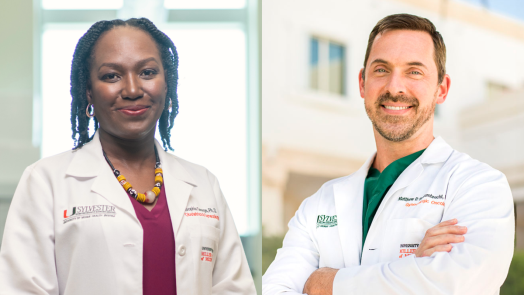Researchers at Sylvester Comprehensive Cancer Center at the University of Miami Miller School of Medicine have received two new three-year, $1 million grants from the U.S. Department of Defense to a Sylvester molecular geneticist, and Matthew Schlumbrecht, M.D., M.P.H., a Sylvester researcher and oncologist who studies gynecologic cancer disparities, will lead research into the genetics of the disease in Black women.

Sophia George, Ph.D., a Sylvester molecular geneticist, and Matthew Schlumbrecht, M.D., M.P.H., a Sylvester researcher and oncologist who studies gynecologic cancer disparities, will lead research into the genetics of the disease in Black women. Schlumbrecht will lead a second study on endometrial cancer awareness among different populations of Black women.
“Endometrial cancer has been understudied for a very long time,” Schlumbrecht said. “There are also clear disparities in experience and outcome with this cancer.”
Black women are more likely to get more aggressive forms of endometrial cancer, and they are more likely to have poorer outcomes than women of other races. The researchers aim to use the new funding to study and eventually identify women at high risk for the disease, the most common form of gynecologic cancer in the U.S.
“This hasn’t really been done before, to survey people who are dying of this aggressive disease at disproportionate rates compared to others in the population,” George said. “There’s a real benefit to understanding what’s happening to women in our community, as well as globally.”
The collaborating scientists previously found that country of origin mattered for endometrial cancer survival among Black women, with Haitian women having lower rates of survival than Black women born in the U.S. or Jamaica. Now, they want to uncover the genetics behind those differences, working with community partners in Nigeria, the Bahamas and South Florida. Better understanding the genetics of endometrial cancer in different populations of Black women will help improve prevention strategies for those at high risk as well as point to potential drug targets to inform new clinical trials.
To better understand the prevalence of hereditary endometrial cancer in different Black populations, the researchers will examine both tumor mutations and mutations in noncancerous cells in Black women with endometrial cancer who were born in the U.S., those born in the Caribbean, and those from West Africa. Overall, 5% to 10% of endometrial cancers are thought to be linked to inherited mutations, but Schlumbrecht said most heredity studies of this cancer have been conducted on primarily white populations — the numbers may be different in other racial groups.
Through the other newly funded project, the Sylvester researchers aim to understand awareness of endometrial cancer – also called uterine cancer – and its symptoms among Black women, as well as barriers to seeking care. No screening methods exist for endometrial cancer, and women are generally diagnosed when they develop symptoms, which typically include postmenopausal bleeding or bleeding between periods in premenopausal women.
The researchers will survey Black women born in the U.S., the Caribbean and Haiti to ask what they would do if they or someone in their family had postmenopausal bleeding. They are also working with University of Miami communications researcher Kallia Wright, Ph.D., to develop a communication tool in partnership with Black women in the South Florida community to raise awareness of endometrial cancer symptoms.
Schlumbrecht hopes to use the data from this project to help raise physician awareness and competency. Although there are clear guidelines for how doctors should test and care for women with postmenopausal bleeding, many physicians may not realize how the symptom is perceived in different communities. Some women may not see it as a problem or may be embarrassed to seek care, Schlumbrecht said.
“We need to be able to say to them, this is what the patients are telling us that they understand, this is why they’re not going to the doctor,” he said. “When they actually make the choice to go to the clinic, we have to be aware of their lived experiences.”
Shakeya Allen, a Black woman who started the nonprofit Uterine Cancer Awareness Network in 2019, will serve as a patient advocate on the genetics study. Starting at age 17, Allen visited several gynecologists for excess bleeding, but it took a visit to a Michigan emergency room after she passed out at age 27 to finally get a diagnosis of endometrial cancer.
That diagnosis only happened because she pushed to get a biopsy while in the hospital, she said. Her doctors had found evidence of cancer cells in a miscarriage she’d had a year prior, but that information had never reached Allen, since she had moved to a different state in the meantime. In Michigan, the doctors initially didn’t want to perform a biopsy, telling her that women under 40 don’t get endometrial cancer; while the cancer most commonly occurs after menopause, Allen turned out to be an exception.
“I had no idea what endometrial cancer was at the time,” she said. “No doctor mentioned it to me; I had never seen any type of information about it in all the doctor’s offices I visited. If I had, I would have been able to advocate for myself sooner.”
Read more on the InventUM blog and follow @SylvesterCancer on X for the latest news on Sylvester’s research and care.
The Editorial Team at Healthcare Business Today is made up of skilled healthcare writers and experts, led by our managing editor, Daniel Casciato, who has over 25 years of experience in healthcare writing. Since 1998, we have produced compelling and informative content for numerous publications, establishing ourselves as a trusted resource for health and wellness information. We offer readers access to fresh health, medicine, science, and technology developments and the latest in patient news, emphasizing how these developments affect our lives.







